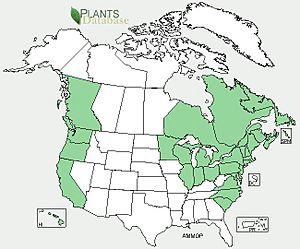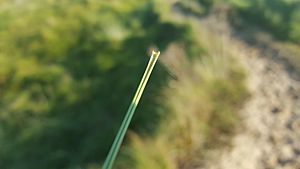Ammophila (plant) facts for kids
Quick facts for kids Ammophila (plant) |
|
|---|---|
 |
|
| European marram grass Dunes near The Hague, February |
|
| Scientific classification |
|
| Kingdom: | Plantae |
| Clade: | Tracheophytes |
| Clade: | Angiosperms |
| Clade: | Monocots |
| Clade: | Commelinids |
| Order: | Poales |
| Family: | Poaceae |
| Genus: | Ammophila Host |
| Species | |
|
|
 |
|
| The range of Ammophila in North America | |
Ammophila is a type of grass that grows mostly on sand dunes near the coast. It is also known as marram grass, bent grass, or beachgrass. This plant has long, creeping underground stems called rhizomes. These stems help it grow well in places with shifting sands and strong winds. They also help to hold the sand in place, which stops coastal erosion.
Ammophila plants are originally from the coasts of the North Atlantic Ocean. They are usually the main type of plant found on sand dunes there. You can also find them inland in a few places, like around the Great Lakes in North America. The name Ammophila comes from two Greek words: ámmos, meaning "sand", and philos, meaning "friend".
These grasses are known as xerophytes. This means they are plants that can live in very dry conditions. Even though they grow by the sea, Ammophila grasses do not like very salty soil. They can handle a little salt, but not too much. This makes them "moderate halophytes," meaning they can tolerate some salt.
Ammophila helps to build coastal sand dunes by trapping sand. Because of this, people have planted Ammophila in many places around the world to help protect sand dunes. For example, the European type, Ammophila arenaria, was brought to places like Australia, New Zealand, and South Africa. It was also planted on the Pacific coast of North America in the late 1800s. However, in most places where it was introduced, Ammophila is now considered an invasive species. This means it grows too much and harms the local plants. Now, people are spending money to try and remove it.
Contents
Types of Ammophila
There are two main types of Ammophila that scientists agree on. Other types have been suggested, but they are often seen as variations or hybrids.
- A. arenaria - This is known as European marram grass or European beachgrass. It grows naturally on the coasts of Europe (as far north as Iceland) and northwest Africa. Its flower spikes can be up to 25 cm long and are quite wide.
- A. baltica - This type, called Purple marram, is actually a hybrid. It is a mix between A. arenaria and another grass called Calamagrostis epigejos. This hybrid is found in parts of northern Europe, from the Baltic Sea to eastern England. Its scientific name is × Ammocalamagrostis baltica or × Calammophila baltica.
- A. breviligulata - This is American marram grass or American beachgrass. It grows naturally on the coasts of eastern North America, including the shores of the Great Lakes. Its flower spikes can be up to 30 cm long and are narrower than those of A. arenaria.
- A. champlainensis - Also called Champlain beachgrass, this type grows on the shores of Lake Ontario and Lake Champlain. Its flower spikes are about 22 cm long. Many experts now think it is just a variation of A. breviligulata, not a separate species.
How Ammophila Helps Dunes
In Europe, Ammophila arenaria is very important for coastal sand dunes. It is the main plant that helps to stabilize and build the front dunes. It does this by catching sand that blows in the wind. Its strong, tough underground stems (rhizomes) then bind the sand together. This creates a strong base for the dunes.
In the British National Vegetation Classification, marram grass is strongly linked to two types of coastal plant communities. In the "Mobile dune" community, Ammophila is the most common plant. In "semi-fixed dunes," where less sand is blowing around, Ammophila becomes less common. Other plants, like Festuca rubra (red fescue), start to grow more.
Uses of Marram Grass
Because marram grass can grow on sand and hold it in place, it is very useful for stabilizing coastal dunes. It also helps with artificial coastal management projects on sandy shores. People realized how useful it was in the late 1700s.
On the North Sea coast of Jutland, Denmark, marram grass was traditionally used for many things. People used it for fuel, for thatch on roofs, and even as food for cattle after a frost. However, using too much of it caused sand to blow away, leading to the loss of farmland. Because of this, laws were made in 1779 and 1792 to promote dune stabilization. This led to a system where "dune planters" were supported by the state and watched over by "dune bailiffs." Marram grass was (and still is) planted using cuttings from its roots and shoots. These are dug up nearby and planted in the bare sand when the weather is calm and moist.
Women from the village of Newborough, Anglesey, Wales, once used marram grass to make mats, covers for haystacks, and brushes for whitewashing.
Marram grass has also been widely used for thatch in many parts of the British Isles near the sea. In the 1600s, so much marram grass was harvested for thatch that it caused dunes to become unstable. This led to many villages, farms, and estates being buried by sand. In 1695, the Scottish Parliament banned this practice. They stated that pulling bent (marram grass), broom, or juniper from sand hills was forbidden to protect lands from being ruined by sand.
How Ammophila Adapts
Like other xerophytes, marram grass is very well adapted to its environment. This helps it survive in a harsh place. Losing water through transpiration (when plants release water vapor) is not good in a dry landscape. Marram grass has special adaptations to deal with this. Sandy conditions drain water quickly, and very windy conditions make plants lose even more water.
Marram grass has a rolled leaf. This creates a small area of concentrated water vapor inside the leaf, which helps prevent water loss. The stomata (tiny pores for gas exchange) are in small pits within the rolled parts of the leaf. This makes it harder for them to open and lose water. The folded leaves also have hairs on the inside. These hairs slow down or stop air movement, much like other xerophytes. This slowing of air movement again reduces how much water vapor is lost. A waxy cuticle (a protective layer) on the leaf surface also stops water from evaporating.
See Also
 In Spanish: Ammophila (planta) para niños
In Spanish: Ammophila (planta) para niños
- List of Poaceae genera


